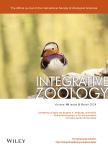Habitat restoration is the greatest challenge for population recovery of Hainan gibbons(Nomascus hainanus)
作者机构:School of Karst ScienceGuizhou Normal UniversityGuiyangChina Department of AnthropologyUniversity of IllinoisUrbanaIllinoisUSA Ministry of Education Key Laboratory for Ecology of Tropical IslandsKey Laboratory of Tropical Animal and Plant Ecology of Hainan ProvinceCollege of Life SciencesHainan Normal UniversityHaikouChina Bawangling BranchHainan Tropic Rainforest National Park AdministrationChina
出 版 物:《Integrative Zoology》 (整合动物学(英文版))
年 卷 期:2023年第18卷第4期
页 面:630-646页
核心收录:
学科分类:0710[理学-生物学] 07[理学] 0713[理学-生态学]
基 金:supported by the project of the National Natural Science Foundation(No.3207030491,No.31770456) the Hainan Gibbon Conservation Research(No.KY-2000105-KT)。
主 题:conservation Hainan gibbon home range area landscape management MaxEnt modeling
摘 要:Hainan gibbons are among the world’s most critically endangered primates,with a remaining population of only 35 individuals distributed across 5 social groups in the Bawangling Branch of the Hainan Tropical Rainforest National Park,China.Habitat conversion and forest fragmentation over the past 40 years have reduced their geographical distribution by 95%.In the absence of a quantitative assessment of the availability of remaining suitable habitat,it is unclear whether this species can survive to the end of this century.We used behavioral observations,ArcGIS,remote sensing,stereo optical imagery,and MaxEnt modeling to identify patterns of Hainan gibbon range use and compare changes in the distribution of suitable forest types and areas of forest fragmentation over the past 20 years(2000–2020).The results indicate that the combined range of the 5 extant Hainan gibbon groups totaled 14.89 km2.The home range of the smallest group(Group E,3 individuals)was 1.51 km2,which likely represents the minimum home range size for this species.The remaining area of highly suitable and moderately suitable habitat totals 26.9 km2.However,habitat connectivity across the gibbon range is very low(less than 0.5),limiting the ability of Hainan gibbons to move between forest patches.The results of this study indicate that the availability of suitable habitat in Bawangling is insufficient to allow for future Hainan gibbon population growth.Therefore,immediate action must be taken to restore,reforest,and establish ecological corridors to reconnect areas of suitable habitat for these critically endangered gibbons.



